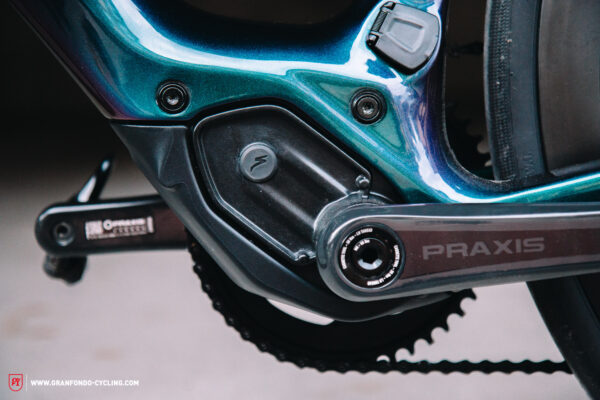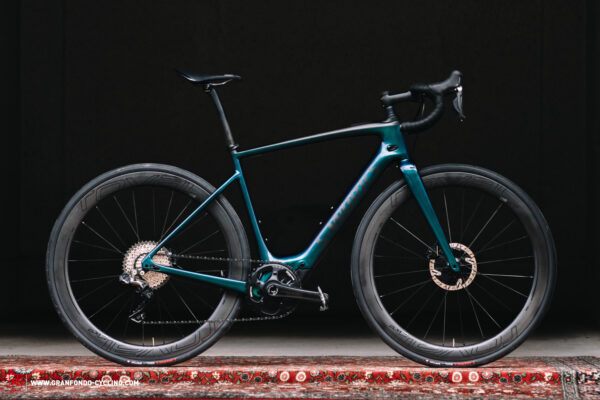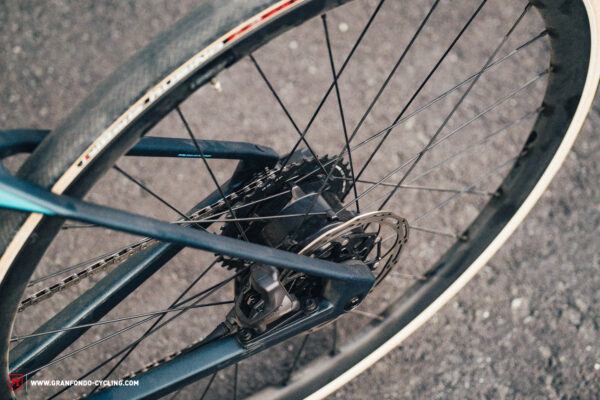Who doesn’t love a bit of tailwind? A new generation of e-road and e-gravel bikes is just establishing itself on the market – and there are big differences in function, performance and price. We sat down with the electric motor experts at MAHLE, who offer both hub and mid-mounted motors, to shed light on this exciting topic.
You see electric motors more and more often, not only on super-performing eMTBs and stylish urban ebikes but also on road and gravel bikes. There are two prevailing configurations: either with a mid-mounted motor in the bottom bracket area or with a hub motor in the wheel axle. When it comes to the topic of hub motors in particular, there is still a lot of confusion and catching up to do in getting people properly informed. In the electric bike community, the hub motor has the standing of the little brother of the mid-mounted motor, although both systems have their pros and cons. We met up with the motor experts and myth-busters from MAHLE to debunk a few of those preconceptions. MAHLE are known as a tech group from the car industry, but have had their fingers in the ebike game for many years. Their portfolio includes both hub and mid-mounted motors. For example, MAHLE developed the SL 1.1 mid-mounted motor together with Specialized, which helped the S-Works Turbo Creo SL win the first ever e-road bike comparison test in 2019. When it comes to hub motors, MAHLE are also at the forefront and currently supply big names such as SCOTT, Mondraker and BMC with the compact X20 drive system. Comparing hub motors with mid-mounted motors may be like trying to compare apples with oranges, but nevertheless, many people interested in e-road bikes are confronted with precisely this question. And if you love fruit, you get your money’s worth either way! That’s why you’ll find the concentrated expert knowledge here – it’s not only exciting for techies but also for everyone who’s up for a bit of an electric tailwind.


Not all hub motors are the same
Not only is it difficult to compare a hub motor to a mid-mounted motor, but there are also many different sub-categories within the same motor types. Just as there are light and full support power units for mid-mounted motors, there are also different approaches to hub motors, differing even more in their design and concept than the mid-mounted counterparts. In addition to the differentiation between front and rear hub motors, a main distinction is made between geared hub motors and direct drive hub motors.
The direct drive hub motor and the geared hub motor
First things first: There is no rule without exception and even with direct drive hub motors there are the exotic ones that do not want to play by all the rules. However, in general, direct drive hub motors are larger and heavier, they do not have an internal transmission or freewheel, and the stator is firmly connected to the wheel axle. The rotor always turns around the stator, which is why direct drive hub motors are also able to recuperate power when freewheeling. They are mainly used in cargo bikes and s-pedelecs, which is why we will skip them somewhat in this review and concentrate on the geared hub motor.


The geared hub motor is de facto the standard hub motor of slim electric road, gravel and city bikes. It is usually smaller, lighter and has an internal freewheel and transmission. The motor turns a central sun gear at high speed, which is translated to a slower rotational speed on the rear wheel via a planetary gear. This allows the electric motor to operate at a more efficient, higher speed. Both motor and transmission sit on a freewheel around the axle and rotate with the wheel when the bike is freewheeling, which means that the gear hub motor cannot recuperate power. In theory, the functioning of a hub motor can be quickly explained, but in practice, countless influencing factors play into the way the motor works and its operating characteristics. The devil is in the details. The gaps in people’s knowledge have given rise to a number of myths surrounding the hub motor.
Myth 1: The hub motor is technically inferior to the mid-mounted motor
You only get one shot at a first impression. And perhaps a bike with a hub motor first popped up on your radar during a visit to the hardware store or supermarket. Retailers initially stocked their shelves with no-name ebikes equipped with hub motors, which sold more on their novelty factor than on their quality. There was not yet much technical finesse in these bikes and that initial impression has lasted. However, modern hub motors do not have to hide behind mid-mounted motors in terms of technology. They can draw on the same high-tech systems and aids as mid-mounted motors to provide a perfect riding experience. The sensors used are similar to those in mid-mounted motors: sensors for torque and cadence, speed and acceleration meters, tilt sensors, and so on. The software to translate the recorded data into motor power that’s delivered on demand is similarly complex to that used on mid-mounted motors. Even the more peripheral technical features, such as individually adjustable motor characteristics, connectivity functions or modular battery concepts, can be found on bikes with hub motors too. You could make an argument that there was a phase of technological catching up or, more simply, technological evolution of hub motors until they were on par with mid-mounted motors – but that is now over, and we should write off the myth of technological inferiority from our minds.
Myth 2: Hub motors are for low-budget ebikes
Image is nothing and yet everything at the same time. For both hub motors and mid-mounted motors, there are low-cost and more expensive systems for the premium segment. In our perception, however, the prevailing image continues to be that hub motors are often used in cheap bikes, and mid-mounted motors in more expensive ones. However, a look at the price tags of the road and gravel bikes with hub motors we recently tested paints a very different picture. Manufacturers sometimes charge five-figure sums for their motorised gems and, at these high prices, would have enough fiscal leeway to buy any motor system and fit it into their bikes. Admittedly, the ebike motor market offers a wide range of low-cost hub motors that make relatively affordable bikes possible, but for manufacturers in the premium segment, the price of the motor system is not as decisive as you might think. If they choose a hub motor, it is because it allows a high degree of integration and also because the performance is right – the aim here isn’t to save some money.

Myth 3: Ebikes with hub motors have poor weight distribution
The fact that hub and mid-mounted motors have different weight distributions cannot be disputed. In terms of ebikes alone, the centre of gravity of a mid-mounted motor bike is usually placed more centrally between the wheels and above the bottom bracket, which is generally beneficial. Whilst with hub motors, part of the weight – namely the motor – moves to the rear into the hub. Experienced bikers will notice the difference: MAHLE’s X20 motor is one of the lightest hub motors on the market, weighing just 1.4 kg, nevertheless, in our tests we could detect a slightly stronger dragging of the rear wheel in curves. On an off-road e-gravel bike, such as the Mondraker Dusty XR, the extra weight at the rear causes the rear wheel to become a little more bumpy on rough descents. However, if you don’t want a super agile bike or are not a curve aficionado, you can have lots of fun with a good e-road bike with a hub motor. Overall, the additional weight in the hub has only a slight influence on the overall character of a bike, but a harmonious interaction of weight distribution and geometry is essential for good handling of bikes with rear-wheel hub motors. Using a hub motor system in particular gives manufacturers a high degree of freedom in terms of frame design, geometry, overall weight and Q-factor. In our field tests, we quickly got used to the more rear-heavy weight distribution after only a short time on the bike. Still, we never got a definable hub motor feeling, as there exist simply too many different ebikes with hub motors, from dynamic and lively to rather leisurely and sluggish; even 2-in-1 concepts like the FMoser Road Force. This versatile e-road bike comes with two rear wheels, one with a hub motor and one without. The FMoser even won the Design Innovation Award for this trend-setting concept.

Myth 4: The question of hub or mid-mounted motor is the choice between low weight and more power
Here, it is like banging your head against a brick wall when talking to the bike community. Hub motors are often reduced to being characterized as light and weak, and mid-mounted motors as strong but heavy. Torque and weight are easily communicated parameters that are conveniently integrated into the manufacturers’ marketing campaigns, although neither the kilograms nor the Newton-metres alone are decisive for a motor system. MAHLE especially oppose the low Nm specifications of hub motors, for example, and they rate the current X20 motor with a torque of 55 Nm. The motor itself only produces a maximum torque of 23 Nm, but since it transmits its power directly to the rear wheel rather than via a drivetrain, it is supposed to feel consistently powerful in all situations – like a comparable 55 Nm mid-mounted motor. The motor experts at MAHLE advise choosing a motor that suits the intended application instead of one that delivers the best values on paper.
It’s a match – The ebike motor must fit the intended use
Sure, you can take the easy way out and choose your ebike on the basis of criteria such as weight, torque and price, but that is not really practical. It is far more important to know what you’re going to use your bike for. MAHLE preferably provide their geared hub motors to manufacturers of purist road, gravel and city bikes. And it makes sense because geared hub motors are optimal for medium and high speeds thanks to the way they work, and come very close to the look and feel of analogue bikes. At slower speeds, however, they reach their limits. What is the reason for this and how do you determine these differences?
Cadence
The hub motor transfers its power directly to the rear wheel, no matter what your cadence is. Hub motor manufacturers should therefore take care to adapt the efficient working range of the motor and the power delivery curve to the actual speed at which the bikers are riding. Then, you can either climb the mountain riding out of the saddle using the biggest chainring or conquer the vertical metres in spinning mode – the motor delivers a torque profile that matches the speed. As a rule, hub motors work most efficiently at medium and high speeds. At low speeds, however, the assist feels weaker. In fact, many bikers find this more natural, as most riders perceive acceleration from a standstill to 15 km/h, for example, as more difficult than from 15 km/h to 30 km/h. The bottom line is that on ebikes with hub motors, you ride at a more natural cadence, just as you would on an analogue bike. Conveniently, hub motors are compatible with the same 1-speed and 2-speed drivetrains as found on analogue bikes.


Mid-mounted motors can only indirectly adjust their torque curves to the riding situation, as the torque always travels through the gear ratio before it is passed onto the rear wheel. These motors, instead, have a rather limited efficient cadence range, usually between 70-90 rpm. This means that mid-mounted motors can build up a lot of power even at very low speeds, as long as the rider is careful to keep the cadence constantly in an efficiently high range. Not every ebike newbie gets it right at first. Bosch, for example, has gear shift recommendations popping up on the display to help. Outside the efficient cadence range, mid-mounted motors can fall out of their power bands. To ensure that this is not too noticeable to ebikers, modern full-power mid-mounted motors are trimmed to a very high peak torque, so that they are enormously powerful even outside their efficient range.
Look and Feel
Even bike purists and aesthetes can appreciate a little electric tailwind on the bike. Also, in the looks and feel department, ebikes with hub motors have a lot to offer. Mid-mounted motors such as the TQ HPR 50 or the Specialized SL 1.1 motor developed with MAHLE have also become very subtle, not only because of their small size, but also thanks to their very naturally tuned motor characteristics. Nevertheless, the almost invisible hub motors hidden between the cassette and brake disc are the ones that remain unbeaten when it comes to creating an analogue bike look. They usually do not require geometry adjustments, do not need additionally reinforced bottom bracket areas with motor mounts or call for wider Q-factors. Still, a bike should of course be designed specifically for the intended use, as, compared to the analogue bike, the handling varies due to differences in weight distribution. Hub motor bikes often come with a permanently installed battery in the down tube, which is particularly slim, while mid-mounted motors are often elongated and protrude into the space where the down tube would already begin on analogue bikes. With hub motors, the down tube remains untouched by design adjustments and the space can be used entirely for the battery, allowing it to be placed further down in the frame. Thanks to modern technology such as torque sensors in the bottom bracket, well-tuned motor software, and the fact that the hub motors act directly on the rear wheel instead of on the chainring at the front, they feel rather natural – but they don’t quite manage to be as subtle as the best mid-mounted motors.


The look and feel also includes pedalling resistance and noise. These undesirable side effects are usually always more pronounced on ebikes than on analogue bikes. Yet current motors have become very low-resistance.They either disconnect internal gears via a freewheel or are inherently designed to have minimal internal resistance. The manufacturers themselves state a measurable pedalling resistance in the low single-digit watt range for their flagship motors. Still, you’ll find a small group of bikers out there who can sense every missing watt and who want completely resistance-free pedalling, just like our “Princess and the Pea” editor Calvin. Even if the popular opinion is that hub motors are advantageous here, it all depends on the manufacturer’s experience and quality control. The same applies to the noise level: Hub motors are said to operate more quietly, partly because they are less noticeable due to their positioning further back on the bike. In fact, again, the experience of the motor manufacturers is the more important factor here. The noise-vibration-harshness behaviour of machines is a science in itself that motor manufacturers have to deal with. It’s worth noting that in the case of mid-mounted motors, the frame also acts as a resonance chamber and plays a further crucial role in noise development.


however, installation and removal is no harder than on an analogue bike, despite the hub motor
Maintenance and wear
There are also functional differences between hub motors and mid-mounted motors when it comes to maintenance and general wear and tear. Both geared hub motors and mid-mounted motors have an internal transmission that is subject to wear. Generally, however, it is designed to run for a very long period of time. While both well implemented hub and mid-mounted motors are real work horses, which is a good thing because in most cases you can’t maintain them yourself, other components are also affected by the motors, increasing the need for general maintenance. For mid-mounted motors, the higher force exerted on the chain, chainring and cassette usually causes premature wear of these parts. As with mid-mounted motors, the crank and chainring do not always rotate in relation to each other and the assistance provided by motors is sustained for a relatively long time, so shifting under load is more frequent. This is because the chainring continues to turn with the motor power while the rider is already decreasing the pressure on the crank, which can be a groupset killer for some drivetrains (cough, money shift, cough). But particularly powerful hub motors require a somewhat stronger wheel, a torque support at the dropout and a correspondingly robust frame design around the axle mount. Also, the electrical connection from the hub motor to the battery and controller provides additional wiring that often makes removing the rear wheel complicated. You usually only notice this when you have a flat tire and involuntarily have to become an electrician, even though you only wanted to fix a puncture. But there are already clever solutions for this, too, such as the MAHLE ACM (or Automatic Motor Connection in human language) system on the X20 motor, which is both a torque support and motor connector in one, allowing the rear wheel to be removed and installed as usual. Those who know the older systems will be aware of what a difference this makes and will appreciate the ACM very much! From experience we know that there is a large group of bikers who don’t want to deal with the technology and maintenance of their bikes, but would just like to get on and go. Regardless of whether you have a tailwind or not: sooner or later you will not be able to avoid servicing your bike. Generally speaking, there is no one motor system that is superior to another in this respect, but there are better and worse implemented solutions that can at least keep the amount of maintenance effort low.

The future of the hub motor
While up to this point we have only looked at existing operational areas, rider types and technology differences, with the hub motor it is also worth taking a look at what awaits us beyond the current technological horizon. Due to its modus operandi, hub motor technology stands out as particularly flexible in some areas of application, whereas the mid-mounted motor encounters technical limitations or exhibits increased complexity. With hub motors, two-wheel-drive bikes are easily imaginable, even allowing rear-wheel steering or torque vectoring between the tires to give gravel bikes more grip on sandy climbs, for example. The first all-wheel drive concepts such as the VanMoof V city bike are already waiting in the starting blocks, but we will have to see how they actually perform when they come onto the market.
A sword is only as good as the arm that wields it
With all the technical details, different functionalities and approaches, it is important to always keep in mind that it never comes down to the motor alone. There is no such thing as the best motor or the best motor system. The best motor is only as good as the bike that contains it. And it only unfolds its benefits when, together with the bike, it fits the individual needs of the person riding it.
Every now and then, we like to have a little tailwind regardless of whether it comes from a hub motor or a mid-mounted motor because contrary to many myths, neither motor has a bike category to itself. The fundamentally different modes of operation offer benefits and drawbacks for every intended use with variations present even within one motor system. But as soon as the area of use and motor setup are right, and the manufacturer’s high level of expertise comes into play, the resulting bikes are great fun to ride.
Did you enjoy this article? If so, we would be stoked if you decide to support us with a monthly contribution. By becoming a supporter of GRAN FONDO, you will help secure a sustainable future for high-quality cycling journalism. Click here to learn more.
Words: Rudolf Fischer Photos: Various







